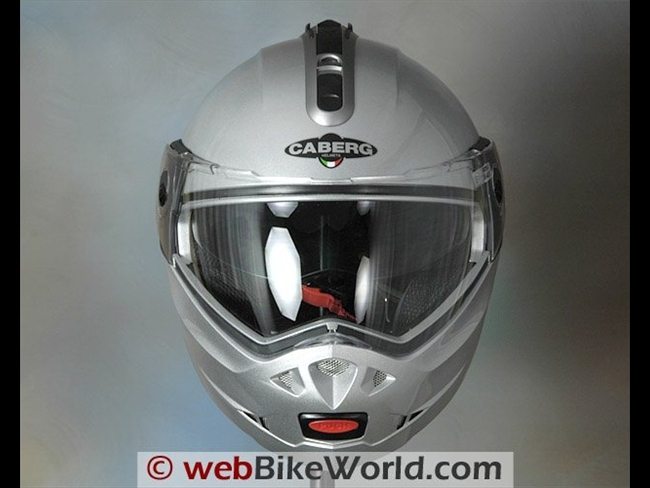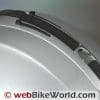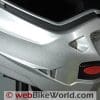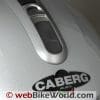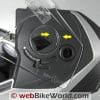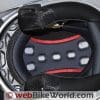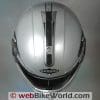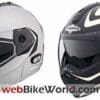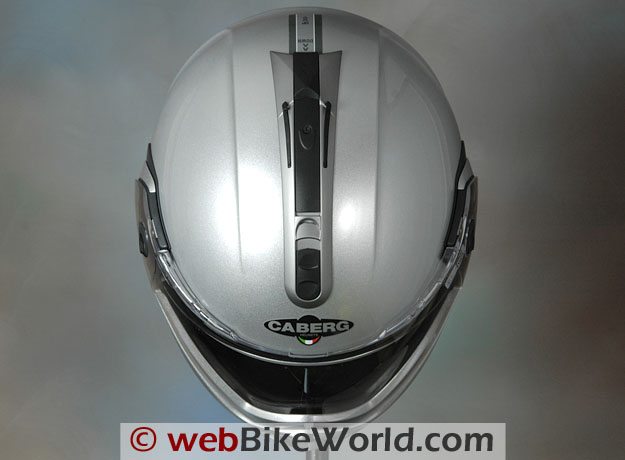The 2010 Caberg Konda is one of the most stylish flip-up helmets available.
It has an outstanding finish and excellent overall quality with generous sizing.
It is also ready for and can be fitted with the Caberg “Just Speak” Bluetooth 2.0 wireless communication system.
The Caberg Konda is new for 2010 and it replaces the much-beloved Caberg Trip (review).
Flip-up helmets generally have “Is that your Grand-Dad’s helmet?” styling, but the Konda is definitely on the leading edge.
A healthy debate could be had deciding between the Konda and the just-as-futuristic Caberg Sintesi (review) for the 2010 style champ.
But my first question was “What’s a Konda?”
A bit of research coughed up a tale of Konda, a mysterious Russian kingdom that lasted until the 18th Century, complete with a Prince and his Court.
While that would be a romantic but rather obscure reference to name a motorcycle helmet, the reality is more prosaic.
Konda is what might be called a corrupted diminutive of the word “Anaconda”.
“Conda” didn’t sound quite right, so “Konda” it was, according to Caberg.
Caberg claims to be the first Italian motorcycle helmet manufacturer to make a flip-up helmet.
Thus, they have a lot of experience in this arena and indeed the Caberg Justissimo (review) has to be the longest-lived flip-up — or any helmet, for that matter — still in production.
This says something about the importance of quality and styling; in fact, even today, we get emails from first-time Justissimo owners with praise for the helmet.
The Konda is also a good value for a flip-up helmet — an important factor for a descendant of the Caberg Trip, which offered a lot of helmet for the money.
The Konda has a list price of £149.99 in the UK and around €170 on the Continent and I’ve seen a street price as low as £115, which translates to only about $140.00 USD in today’s exchange rates.
Note, however, that the Konda is not imported into the North American market and it is not certified to meet DOT standards and there are no plans to do so.
It does, of course, meet ECE 22.05 safety standards where it’s homologated as a full-face helmet.
Caberg Konda Paint, Graphics and Overall Quality
The Konda comes in a limited array of colors, including white, black (and variations thereof) and the very nice silver shown here.
The paint on this example is outstanding, with a perfectly applied finish with tiny little metallic flakes that can be seen in the video close-ups (below).
Caberg also uses what we can only term as a “hard” clearcoat finish, something we have mentioned before in webBikeWorld reviews.
There is something about the clearcoat used by Caberg and a few other European helmet manufacturers seems different from the “softer” clearcoat formula used on other helmets we’ve reviewed.
The clearcoat protecting the helmet’s surface doesn’t necessarily look thicker than average, but it has a different feel.
I can tap my fingernails on it and it just feels hard to me and, based on my experience with other Caberg helmets, it should protect the helmet better than the surface finished on other helmets I’ve owned.
One of the best compliments I can give the Konda is that I don’t feel like I’m wearing a flip-up when riding — at least not after I lower and secure the hatch, so to speak.
The moving bits and pieces on the Konda feel nice and firm, without a lot of the squeaking and groaning noises heard on other brands of flip-ups I’ve worn.
The rotating visor has a quality feel when it’s raised and lowered with the soft-touch button located right in the middle of the chin bar where it’s easy to find.
The visor also has a strong detent at the top, so it should remain firmly in the raised position during those fuel and Mars bar (aka Snickers in Yank-ese) stops.
The liner in the Konda may not be as plush as a £600 Arai RX-7, but it’s nicely made and assembled into the helmet. Finally, the vents and other parts all work as expected with no flaws to report.
The large and unique-looking clear face shield fits snugly against the eye port gasket, although there are slight gaps at either side that will allow some water to enter.
That should be a rare occurrence though, as the shield has molded-in guards at the top and the gaps in the gasket are at the farthest end of each side.
Score: The Caberg Konda gets an “Outstanding” rating from me for overall for quality. See the Summary Table at the end of this page for a description of our rating system.
Caberg Konda Helmet Fit, Comfort and Internal Shape
The Konda has what I might call a generous fit that is actually very similar to the most recent SCHUBERTH C3 (here’s a review of original C3).
The reason I know this is that we’re currently also evaluating a pair of C3’s complete with the SCHUBERTH Bluetooth communication system and that review will be published soon.
The big difference though is that a size large for the Caberg Konda is listed as 59-60 cm, while the size large for the SCHUBERTH is listed as 58-59.
I’d guess that SCHUBERTH tried to squeeze a large into a medium shell size, because it has to be the smallest-feeling size large I think I’ve ever tried.
On the other hand, the Konda with its 59-60 cm fit feels generous and I think a 61 cm head should also be able to fit. The helmet does feel slightly top heavy, as do most flip-ups in my experience.
This is minimized somewhat when the rotating visor is lowered and locked, but the dramatic cut of the eye port (description to follow) also adds to the feeling that the helmet is sitting a bit high.
The shape is just to the round side of neutral, so I’ll call it a “Slight Round”.
But it should fit the widest majority of head shapes with no problems, as long as the potential owner’s head profile isn’t too far from average.
The Konda liner is removable, but I’m not sure if Caberg sells different size cheek pads and liners to make a more custom fit.
The helmet is available in sizes ranging from XS to XL only, so no XXL for the Konda.

I’ll give the Konda a “Slight Round” shape designator in the Estimator chart above; similar also, by the way, to the AGV T-2 full-face helmet that was just reviewed also. As always, note that different head shapes and different helmet sizes can cause a helmet to fit or feel differently than I am describing here, depending upon the individual.
More information on helmet fit can be found in the chart that lists the helmet weights of webBikeWorld reviewed helmets and also by shape on the webBikeWorld Motorcycle Helmet Shapes page.
The liner material used in the Konda is comfortable but perhaps slightly on the thin side.
There are no specific eyeglass channels molded into the liner and I did have a bit of trouble hooking a pair of wire-framed sunglasses over my ears once the helmet was on.
But because it’s a flip-up, this shouldn’t be an issue as the helmet can be carefully slipped on over the eyeglasses if necessary.
Score: I’ll give the Caberg Konda an “Outstanding” rating for overall comfort and fit.
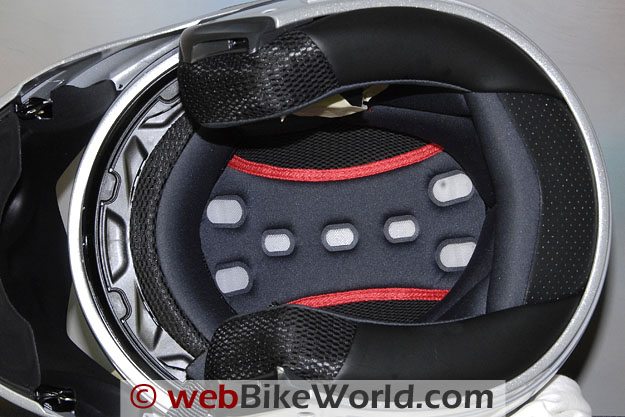
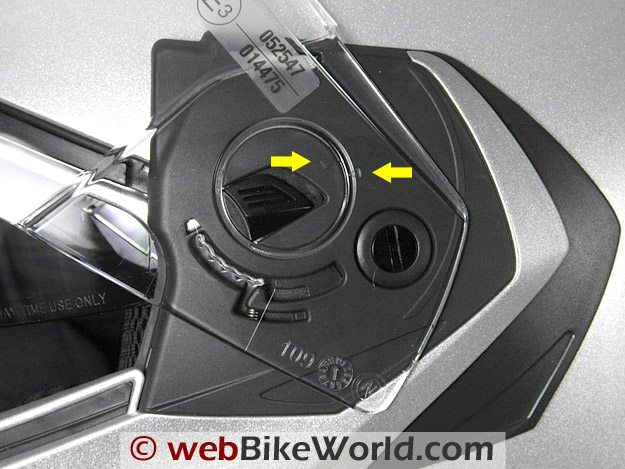
Caberg Konda Visor and Face Shield
The large rotating flip-up visor is the most distinguishing feature of the Caberg Konda; it is styled as a cross between a jet fighter pilot helmet and something seen in the Star Wars film.
Look at the slide show photos above and pause at the side view of the Konda and take a look at the mouth and I bet you’ll agree it looks vaguely like one of the characters in the movie.
The rest of the helmet has some unique shapes and character lines also, but it’s the visor with its scalloped eye port that makes the big difference here.
I was initially skeptical about how those sculpted eye cutouts would affect the view once the hatch was secured.
And while they were disconcerting at first, I quickly became used to them and in fact I really don’t think they affect the view any more than an average helmet.
The rotating flip-up visor has metal hooks that latch into plastic receivers in the helmet shell, and this provides a secure overall feeling once the visor is clicked shut.
In back-to-back rides wearing the Konda, the AGV T-2 (review), the SCHUBERTH C3 (review of older version) and the Shark S900 (review coming), the Konda gives about the same amount of view as any of the others.
There is one big difference, however. The Konda does have a tight front-to-back internal fit, so my chin touches the back of the chin bar inside the helmet.
The padding inside the chin bar feels thicker than average, but the internal dimensions may be an issue with some riders, depending upon their head or chin shape.
Otherwise, the clear face shield also operates smoothly and it has outstanding optical qualities. It has 5 detents and the first opening is a bit larger than I’d like, but it snaps open and closed with a good feel, so I’m pleased.
The lifting tab is located at the center of the face shield, making it easy to reach with either hand.
The face shield measures 2.05 mm thick with our micrometer.
It is rather easy to remove; just rotate it upwards until the two molded-in arrows meet (see photo above) and push the release button towards the rear and the shield will release.
The face shield is coated to help prevent fogging and it’s also treated with an anti-scratch coating.
The anti-fog treatment seems to work in the limited range of warmer temperatures I experienced during the evaluation, but UK owners may want to secure a bottle of Clarity Defog It (review) just in case — it’s the best anti-fog treatment we’ve used so far.
Internal Sun Shield
The Konda also features an inner rotating sun shield. It operates with a rather large slider on top of the helmet that is placed as part of the top vent assembly.
The slider is a friction unit, so the sun shield can be stopped at any position, which is a definite plus. It doesn’t rotate down quite as far as I’d like.
But it is just below my line of sight and the scalloped edge along the bottom is relatively shallow so it works pretty well.
I like having the ability to stop the sun shield above my eyes, which helps when the sun is bright and overhead or when riding into the setting sun in the evening.

Score: Overall, the mechanical system for the rotating visor and clear face shield on the Caberg Konda I would rate as “Excellent”, with the internal sun visor as a “Neutral”.
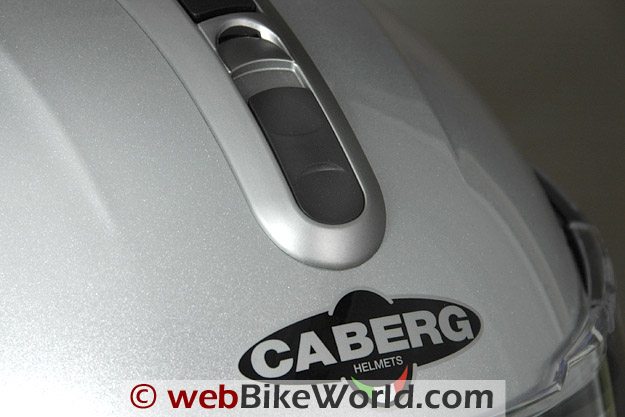
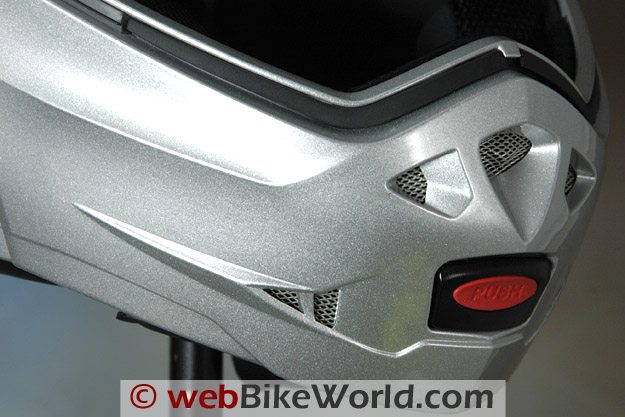
Caberg Konda Ventilation and Air Flow
The Konda has a basic ventilation system, wit
that large chin vent flowing air up on to the back of the clear face shield only, through three channels along the top of the chin bar.
The helmet does not have an on/off slider switch for the chin vent, so the vent can not be closed.
This isn’t much of an issue though, because ventilation is almost always necessary and since there are no direct air channels through the chin bar itself, the air flowing in along the top of the chin bar is the only ventilation available.
The tight front-to-back dimensions inside the helmet and the large and tall chin bar result in some close quarters around my mouth.
This is especially noticeable at slower speeds in warmer weather, where it can get pretty warm inside.
It would have been nice if there were vent channels directly through the chin bar, but this is a rare feature on flip-up helmets.
The top vent is covered by a small slider at the front of the assembly that also houses the slider for the internally rotating sun shade.
The entry hole for the air flow is small and the air must go up and over the lip of the assembly to enter the helmet.
Also, the helmet has no rear exhaust vents, so there isn’t much to pull the air through.
Nevertheless, the helmet seems to have about average air flow anyway, which probably illustrates that either the other helmets with all their fancy ducting work are just for show, or the Konda’s system has more intelligence than I’m giving it credit for.
This said, I haven’t tried it on a really hot day yet — our cooler Spring temperatures can mask the efficiency of a helmet venting system.

Score: The always-on chin vent system on the Caberg Konda gets a score of “Good” and would probably be better if air was directed through the chin bar itself. The top vent and lack of a pull-through exhaust system gets lower marks.
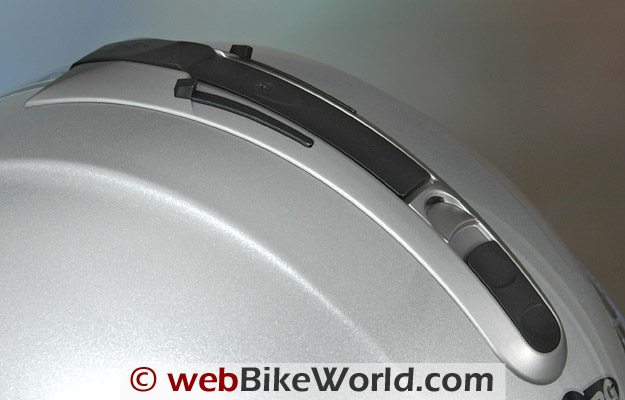
Sound Levels
The Konda seems to follow what is apparently a new trend in design that we’ve noticed lately; the profile has a dropped chin and raised back, which is more apparent when looking at the helmet from the side.
It’s not quite as dramatic on the Konda as on some other helmets I’ve worn recently, and this design may be to help keep the back of the helmet from fouling against jacket collars when in the leaned-over Sportbike riding position.
This wouldn’t be a problem but if this is in fact a new design trend, then it may be necessary for the manufacturers to consider making the padding at the bottom of the helmet (the so-called “neck roll”) thicker.
This could fill the gap that forms between the rider’s head and the inside rear of the helmet.
The rear of the helmet is in the high-turbulence area and any area that isn’t sealed will allow noise to enter.
This seems to be the case with the Konda, although this also depends quite a bit on the match of the helmet to the rider’s head shape — yet another reason why finding the perfect fit is so important.
I notice an increased volume around the back of the helmet and the source is quickly identified by placing a hand back there, and the noise is immediately diminished.
The noise doesn’t really diminish even when riding in a more straight-up sitting position on a bike without a windscreen.
So I’d have to say that in general the Konda seems to transmit more noise than average around the bottom of the helmet, with the upper portion of the helmet having the average amount of wind noise that is common with any helmet design.

Note that our helmet evaluations are a combined effort of several riders over time on different types of motorcycles with and without windscreens.
Evaluators wear correctly fitted, high quality ear plugs (even when evaluating motorcycle intercom systems).
Always protect your hearing when riding a motorcycle. See the wBW Earplug Reviews for more information on choosing and wearing earplugs.
Note also that perceived noise levels will vary, depending on the individual.
Noise can be caused by many factors, including helmet fit, the type of motorcycle and windscreen, wind speed and direction and even the rider’s clothing.
For more information on helmet noise, visit the wBW Motorcycle Helmet Noise page.
Score: Overall, my feeling is that the Caberg Konda is slightly louder than average but this may depend upon the fit of the rider’s head to the helmet and other factors, so I’ll give it a “Neutral” score.
Helmet Weight
The size L Caberg Konda shown here weighs a comparatively light (for a flip-up) 1755 grams (3.0 lbs. 13-7/8.0 oz.), which, although heavy compared to a full-face helmet, isn’t bad actually.
For example, the weight compares well to the full-face Vemar VSREV (size L) at 1748 grams; the brand-new Arai Corsair V (XL) at 1758 grams and the HJC Sy-Max II (Flip-up) in size large at 1762 grams.
Other than the slight top-heavy feeling described above, the comfortable fit and tight seal when the visor is closed gives the Konda good balance for a flip-up helmet.
Score: I’ll give the Konda an “Excellent” rating for its lower than expected weight for a helmet of this type and with an internal sun shade.
See the wBW Motorcycle Helmet Weights page for a chart that compares the weights of all of the helmets we’ve reviewed. The wBW Motorcycle Helmet Shapes page lists the helmets by head shape and weight.
Miscellaneous
The Konda uses the European-style quick release buckle, which works fine but my preference is for a double D-ring system.
The ear pockets feel slightly smaller than average in their dimensions, including depth, although the helmet is ready for the Caberg “Just Listen” Bluetooth communication system.
The T-2 meets ECE 22.05 safety standards only and ACU Gold approval (not confirmed) in the UK.
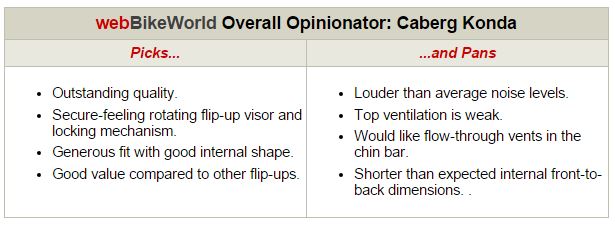
Conclusion
The Caberg Konda is a great-looking helmet that should satisfy anyone looking for style and not finding it in most of the flip-up helmets available today. Is it an improvement over the Trip?
We unfortunately no longer have a Trip for comparison, but if memory serves me correctly, I can say that the Konda has better overall quality (some Trip owners complained about that issue) but the Konda isn’t as quiet as the trip.
But in the end, the Konda is a worthy replacement for the Trip and the combination of style and design and the lower price point compared to other flip-ups makes it a worthy choice.
| wBW Review: Caberg Konda Helmet | |
|---|---|
| Manufacturer: Caberg Helmets | List Price (2010): £149.99 |
| Colors: Solids, graphics. | Made In: Italy |
| Sizes: XS-2XL Shell Sizes: Unknown | Review Date: May 2010 |
|
Rating Scale is subjective: Unacceptable, Poor, Neutral, Very Good, Excellent, Outstanding.
|
|
Note: Item provided by a retailer, distributor or manufacturer with these Terms and Conditions.
Owner Comments and Feedback
See details on submitting comments.
From “P.H.” (February 2013): “I got one of these awhile back. It’s a 5-star rated modular on the SHARP site, not that expensive, and received in ~ a week from the UK. It’s pretty comfy.
But it’s very loud, more so than other modular helmets I’ve owned. Also the sun visor sux, not that big a deal since I usually wear shades anyway. I’ll keep trying to work on it.”
Update From “P.H.” (March 2013): “I’ll “take back” what I said (above). The problem is this helmet just doesn’t fit me properly.”


